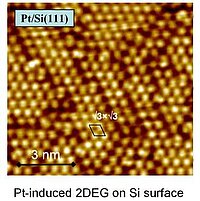Correlated 2D Electron Gases on Semiconductor Surfaces
A two-dimensional electron gas (2DEG) is known from semiconductor technology to exist at interfaces, however, it can also be generated on semiconductor surfaces through metallic adsorbates. Coverages in the submonolayer regime here lead to exotic properties: while the 2DEG system is initially metallic, it can fall into a Mott-insulting state at low temperature. It results from the high degree of localization of the metallic adatoms. Such behavior has recently been established for the triangular-lattice reconstruction of Sn atoms. In turn, systems are known such as In near monolayer coverage on Si(111), which represent a virtually free electron gas in 2D.
This demonstrates how at surfaces the parameters of phase space become accessible for experimental variation: the degree of electron correlation can be varied in a wide range through coverage, substrate type and adatom species. A specialty is that the phase diagram can also be influenced by additional doping. Furthermore, it is a fascinating speculation from the theoretical side that superconductivity based on electron correlation is predicted. Systematic studies for various model systems at surfaces thus deliver a new approach to the physics of correlated electron gases.


